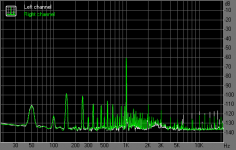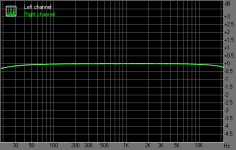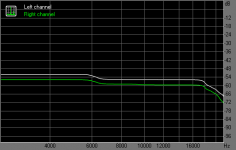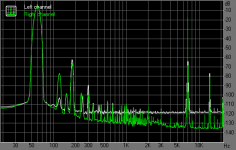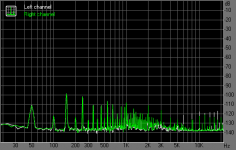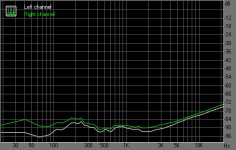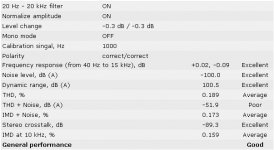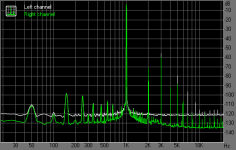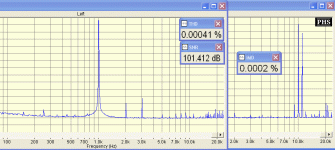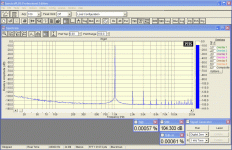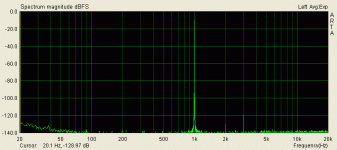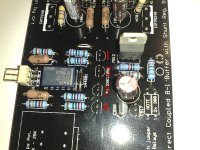First at all, why did you knew that it was rolling off? Did you used measurement equipment to check it? Or did you use any software tester like rightmark and a soundcard?
Because I have, and mine outputs straight as a line. Please, do that before making assumptions based on subjective impressions. Post your picture from rightmark too so we can aim to diagnose your problem.
Going from metal films to carbon composition is not going to make any objective difference.
Can you post rightmark measurements of your build? I wanna see how they compare to dedicated FFT software. What soundcard?
So now its subjectively flat? Because to such a degree of treble loss you describe it should have been a very serious problem. Most likely oscillation. Do you have long interconnects on input/output? What type of wire construction, shielding?
Yes, it is now subjectively flat. Sounds about the same in response as the NAD C160 preamp that it replaced. The interconnects I am using are 1 meter Belkin. The test build is fairly amateur. I've used what I had to make it work before I rebuild it into something nice. I did have some small signal shielded coax for the input and output. I also used some solid core copper telephone wire to finish connecting the jacks and volume control to the coax. It isn't pretty but I just wanted to test the circuit before I ordered any more parts.
Another way that I could describe what it sounded like when it had the problem is this. Imagine you come home and notice that almost all the treble was gone when you turned your stereo on. You have a pair of two way speakers that cross over at about 1500 Hz. Your son got happy with your stereo while you were out and killed both of the tweeters. It was about that bad.
Last edited:
Sure I have made my measurements. Give it an eye and you will see some odd differences.
My soundcard is an EMU0404 USB wich has been changed the dc blocking capacitors for some pannasonic FM's. I made a loop with two homemade TR->RCA cables from its output to its input. Then I placed my DCB1 with its LDR volume control inside the loop.
I will upload here my measurements WITH the buffer. In my next post are my measurements without the buffer,
enjoy them
My soundcard is an EMU0404 USB wich has been changed the dc blocking capacitors for some pannasonic FM's. I made a loop with two homemade TR->RCA cables from its output to its input. Then I placed my DCB1 with its LDR volume control inside the loop.
I will upload here my measurements WITH the buffer. In my next post are my measurements without the buffer,
enjoy them
Attachments
The software is Rightmark Audio Analyzer. And it is a very easy and effective software to use, I encourage to try it. You have to connect the output of a soundcar to the input o fthe same or another sound card in the same computer. Run the software, is free, and put between input and output as many audio gear as you want to measure in chain.
Be careful with doing things like hooking up a power amplifier. IT WILL MAKE FIRE.
Preamps, buffers, and in general all line level devices use to be safe.
Regards,
Regi
Be careful with doing things like hooking up a power amplifier. IT WILL MAKE FIRE.
Preamps, buffers, and in general all line level devices use to be safe.
Regards,
Regi
I see much harmonic noise. Does it still have it when you loop the card alone? You may need to ground lift. Mine FFTs you have seen recently. This pdf one is Grufti's. He had posted long before. My system shows the floor down to -140dB to the right with the DCB1 in, so the needle on Grufti's shows also its root along with some interference in the EMU to the far right which is in its loop with those software settings.
Attachments
Your son got happy with your stereo while you were out and killed both of the tweeters. It was about that bad.
Usually it's me who kills tweeters or even midrange horns here, not my son
Why you wonder? Its there in the Emu Tracker's solo loop. In Grufti's it ain't. But it can reveal 10dB less so it hides some loop gremlins. Its mainly the settings to get the floor so low and the artifacts created.
The simple thing to see is that the DCB1 just lifts the noise floor a bit and improves the distortion. -130dB to -140dB (ref 0dB=1V), give or take, given the card and software beyond 1kHz is seriously silent. Must be one of the cleanest things line.
The simple thing to see is that the DCB1 just lifts the noise floor a bit and improves the distortion. -130dB to -140dB (ref 0dB=1V), give or take, given the card and software beyond 1kHz is seriously silent. Must be one of the cleanest things line.
Salas
how about different wiring at mute relay - output signal goes to output RCA connector and between there Is connection with mute relay NO contact to com to gnd
at first the relay Is not powered so output signal goes to gnd, when cap Is charged the relay click and the gnd goes to NC which Is not connected and the output signal goes to output RCA
that way signal Is not passed through relay contacts
how about different wiring at mute relay - output signal goes to output RCA connector and between there Is connection with mute relay NO contact to com to gnd
at first the relay Is not powered so output signal goes to gnd, when cap Is charged the relay click and the gnd goes to NC which Is not connected and the output signal goes to output RCA
that way signal Is not passed through relay contacts
In use ...
Now that I have had some time to listen to the DCB1 I can say that I am really pleased with what it is doing. It is a better preamplifier than a NAD C160 by no small margin.
Subjectively it does less to the signal that passes through it than the NAD does, which is what I was hoping for. It is easier to hear some of the subtle sounds that are on the recordings. More of the bodies of the instruments than just their voice if that makes sense. It does less to supress the dynamics than what I had and the stereo image is enhanced. But what I am the happiest about is how it performs in the bass region. Definitely more definition. I had mistakenly thought that with the planar speakers that I am using that I had not found the right placement for them yet. Now I know ... the NAD wasn't quite letting loose of the bass notes as well as the DCB1 does.
The only out of place quality that I was hearing was a little mis-proportion in the vocals which were just a little ... chesty. However that disappeared after I had played it long enough (about 18 hours) And it was interesting when it happened, too. It audibly faded away in a few seconds. I've never heard anything like that but it that was the last caveat to it. Great pre-amp.
The basic measurements ...
2 sets 2SK170 matched at 7.7 mA lds in the buffer circuit
20K Ohm Alps volume control
DC offset of 1.1 mV and -.6 mV
Regulator voltage +10.65 and - 10.00 Volts.
Regulator current is about 130 mA with 2.01 & 1.96 Volts across each 15.4 Ohm resistors.
The system I am using it in ...
Musical Fidelity A324 DAC > DCB1 > Marchand XM-9 > Sunfire Cinema Grand Signature II amplifier > Magnepan 2.6 speakers and Velodyne CT-150 subwoofer ... And it has never sounded better!
The next steps are to use film caps for the LED strings and for attaching the Lightspeed volume control. Perhaps increasing the regulator current to 150 or 180 mA as I am still a little consevative with where I have that set.
Thanks very much for this project. I have to admit this is a lot more fun than just going out and buying a new piece of gear.
Now that I have had some time to listen to the DCB1 I can say that I am really pleased with what it is doing. It is a better preamplifier than a NAD C160 by no small margin.
Subjectively it does less to the signal that passes through it than the NAD does, which is what I was hoping for. It is easier to hear some of the subtle sounds that are on the recordings. More of the bodies of the instruments than just their voice if that makes sense. It does less to supress the dynamics than what I had and the stereo image is enhanced. But what I am the happiest about is how it performs in the bass region. Definitely more definition. I had mistakenly thought that with the planar speakers that I am using that I had not found the right placement for them yet. Now I know ... the NAD wasn't quite letting loose of the bass notes as well as the DCB1 does.
The only out of place quality that I was hearing was a little mis-proportion in the vocals which were just a little ... chesty. However that disappeared after I had played it long enough (about 18 hours) And it was interesting when it happened, too. It audibly faded away in a few seconds. I've never heard anything like that but it that was the last caveat to it. Great pre-amp.
The basic measurements ...
2 sets 2SK170 matched at 7.7 mA lds in the buffer circuit
20K Ohm Alps volume control
DC offset of 1.1 mV and -.6 mV
Regulator voltage +10.65 and - 10.00 Volts.
Regulator current is about 130 mA with 2.01 & 1.96 Volts across each 15.4 Ohm resistors.
The system I am using it in ...
Musical Fidelity A324 DAC > DCB1 > Marchand XM-9 > Sunfire Cinema Grand Signature II amplifier > Magnepan 2.6 speakers and Velodyne CT-150 subwoofer ... And it has never sounded better!
The next steps are to use film caps for the LED strings and for attaching the Lightspeed volume control. Perhaps increasing the regulator current to 150 or 180 mA as I am still a little consevative with where I have that set.
Thanks very much for this project. I have to admit this is a lot more fun than just going out and buying a new piece of gear.
Last edited:
I've pointed the pins for measuring voltage on the pic.
What value should I find there ?
I found -9.48 and +10.14v at the pins.
-26 and +25.6 at the 2x68R.
Correct ?
Attachments
Is your transformer more that 15+15 AC when measured feeding the project? Your Vout(s) are OK. If your filter capacitors are 35VDC and there is sinking to the Mosfets, then the 15VDC Vin-Vout isn't a problem. Its expected to be about 10-11V most difference so not to create surplus heat. If you can tackle that, it will be safe. Are you taking those measurements on a fully stuffed board?
- Home
- Amplifiers
- Pass Labs
- Building a symmetrical PSU B1 buffer
